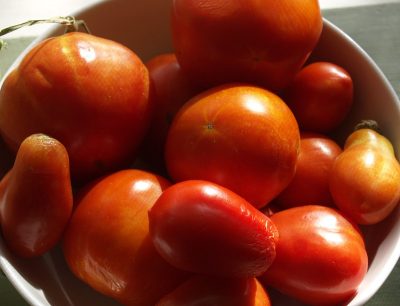Get Growing with Tomatoes

by Trisha Shirey
There’s nothing like the flavor of a freshly picked, ripe tomato from your home garden. There are a few important things to consider in order to ensure that you will get a bountiful, healthy and tasty crop of tomatoes.
- First is the size of the plant. Tomatoes come in Determinate or Indeterminate varieties. The size of a determinate or bush type tomato is typically thirty inches to four feet tall. They will tend to put on a large crop at one time. This makes them ideal for container plants and for gardeners who want to can or preserve the harvest. Some of my favorite determinate varieties include: Celebrity, Patio, Roma, La Roma and Rutgers.Containers for tomatoes should be at least 10 gallons or 15 inches in diameter. A deep pot is ideal and a good quality potting soil mix, not garden soil, is recommended.
- Indeterminate tomato vines keep growing. They require large, sturdy cages and are not recommended for containers. They fruit over a long period. Many of the heritage tomatoes like Brandywine and most cherry tomatoes will be Indeterminate types. We often keep the vines of Indeterminate tomatoes growing from April until a freeze occurs in December. Some of my favorite Indeterminate types are: Large Red Cherry, Juliet, Cherokee Purple and Sungold.
- There are often capital letters on the tomato labels that signify the diseases that variety is resistant to. If you have root knot nematodes in your garden, always look for tomatoes that have an N for resistance to nematodes. Other disease codes include:
- V – Resistance to verticillum wilt
- A – Resistance to Alternaria leaf spot
- F – Resistance to Fusarium wilt
- FF – Resistance to Race 1 and Race 2 Fusarium
- L – Resistance to Septoria leaf spot
- T – Resistance to Tobacco mosaic virus
- When choosing your plants, look for short, stocky plants with lots of deep green leaves. Avoid plants that are flowering or have fruit set. They have been in the pot too long and will take longer to produce that first crop of tomatoes. Avoid plants that have long roots protruding from the pot. They made be stressed from being too crowded and in the pot too long. Plants that are tall and leggy may not have had sufficient light and will have weak stems.
- Tomatoes are tropical plants so they do not like to be outside when temperatures are below fifty degrees. Although we are currently having daytime temperatures in the 70 degree range, our night time temperatures are in the mid to upper 40’s and that could damage the tomato plants.? I pot four inch containers of tomatoes into one gallon containers and keep them in the greenhouse, feeding them weekly and allowing them to be in the sunshine and fresh air during the day. I remove the seed leaves and one set of true leaves and set the plants a little deeper in the pots with some earthworm castings and a little tomato food at the base of the plant. A light wind and freedom from crowding stimulates the plants to have strong sturdy stems.
- I prefer to purchase plants from a local garden center that keeps them in a greenhouse and protects their plants at night. Ask your local nursery if they do that. The plants could already have suffered from cold damage before you plant them! Look for leaves that appear singed or brown and stems and leaves that are deep purple. That could indicate that they have experienced significant cold. Weak tomatoes will have more disease and insect problems.
- When planting the new tomatoes in the garden I generally set them a little deeper in the soil again and trim off lower leaves so that no leaves are touching or are near the soil so that soil borne fungal and bacterial diseases are less likely to be transferred to the plant. Wait to mulch until the soil is warms and the stems are tougher.
- Cutworms can be devastating for the tomato gardener! You find your plant on the ground, sheared off at the soil line. Foil cutworms with heavy duty aluminum foil. Take a 10 inch long piece of foil and roll it on a diagonal. Take the two thinner ends and twist them around the base of the plant. Don’t make it too tight! These collars can stay on for the entire growing season and can even be reused for the next planting. Cutworms will not go around the foil.
- Some people recommend pruning of tomato plants, especially the suckers which come out at leaf nodes. I remove some of the suckers near the soil line but leave on all the foliage possible to protect the crop from sunscald.
- Tomatoes are heavy feeders, so be prepared to apply seaweed spray, liquid fertilizer and granular fertilizer regularly to get the plants growing quickly. Once the plants have set fruit, scale back on fertilizer but mulch well and water consistently. Over watering and under watering can cause problems with fruit.
- Get your plants out as early as possible, especially in warmer Southern climates. Many varieties of tomatoes will bloom, but fruit will not be set when temperatures are above 90 to 95 degrees. Gardeners who plant too late may have lush plants without any tomatoes unless there are a few days of cooler temperatures in late May and June. Cherry tomatoes will generally still produce fruit in the heat.
- Plants may still require night time protection after planted in the garden. Row cover, one gallon milk jugs, sheet plastic can all be used for evenings below 50 degrees. Be sure to remove the covers before the heat of the day cooks the plants.
Enjoy those tomatoes!
categories:
tags:
related:

 Trisha Shirey
Trisha Shirey